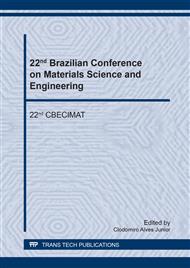p.356
p.362
p.368
p.374
p.380
p.386
p.390
p.395
p.400
Influence of Strain Amplitude on the Functional Properties and Aging at Room Temperature of a Superelastic NiTi Alloy
Abstract:
The effects of strain amplitude variation on the functional properties of a superelastic NiTi wire were investigated in terms of critical stress to induce martensite, accumulated residual strain, dissipated energy, lower plateau stress, and stress at maximum strain. Wire specimens were subjected to training by pseudoelastic cycling, being mechanically strained up to strain amplitudes of 4, 6, 8, 10, 12 and 14%. A total of 20 cycles were performed at each condition at room temperature and strain rate of 10-3s-1. In order to assess if the wires were able to maintain stable their functional properties after training, samples subjected to cycling at 8 and 14% strain amplitudes were aged at room temperature and retested. The results showed that the functional properties tend to stabilize faster when the alloy is subjected to lower strain amplitudes. It was observed that part of the functional properties was recovered if aged at room temperature.
Info:
Periodical:
Pages:
380-385
Citation:
Online since:
September 2018
Price:
Сopyright:
© 2018 Trans Tech Publications Ltd. All Rights Reserved
Share:
Citation:


